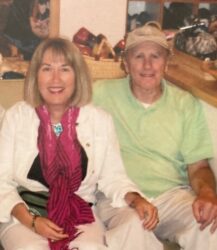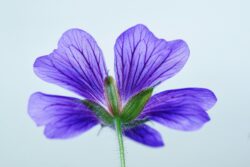Awakening Spiritual Life

When my father was a young minister and doctoral student in the Boston area, he would listen to weekly radio broadcasts by Howard Thurman, the first African American chaplain at Boston University. Later, my father described to me the clarity and calm in his voice, as if each word was a pearl on a string.
My father considered Thurman to be one of the greatest individuals he knew. He explained that Thurman’s life was devoted to cross-cultural understanding, respect and community—not only within the United States in the field of civil rights, but also among cultures of the world. From hosting international students in his home to sipping tea with Asian monks, to visiting with heads of state as well as the poorest of the poor, he seemed to be at home and to experience a common core within and between each human being.
Through the years when I came home for visits, my father and I sometimes talked about Thurman. I remember one summer vacation in college I discovered on my father’s bookshelf a book by Thurman called In Search of Common Ground. As I read the book through the summer, I excitedly shared with my dad my discovery of how Thurman was intrigued with the intimate interconnectedness of all living beings, from human to animal to plant. Collecting stories from cultures around the world, he shared anecdotes that expressed his awareness that all living beings are interrelated through experience of the common source of life.
My father and I were very intrigued by Thurman’s own personal experiences that we discovered in other books by him. We found that Thurman’s sense of the interconnectedness of all of life was based in his own direct experiences of deep inner silence and unity—his spiritual nature.
What is spirituality? Many of the religions of the world have discussed a transcendent field within each person that unites us to each other and even unites us to the essence of all material creation. Poets, philosophers and also scientists refer to a unified field of nature that is the silent essence of all things and is expressed in the infinite variety of life around us. To experience that inner field—even a short glimpse of it—is considered a spiritual experience; reflecting the value of that experience as it unfolds more and more in our life allows us to live a spiritual life—that is, a life that reflects harmonizing, nourishing, uplifting, reverent qualities. Whereas the experience of spirit is not dependent on formal religious study, the fulfillment of religion is dependent on spiritual values.
I remember one visit when my father had bookmarked a couple of passages in Thurman’s Meditations of the Heart. As we talked over breakfast, he read to me Thurman’s words, “There is very great virtue in the cultivation of silence, and strength to be found in using it as a door to God. Such a door opens within.”
Handing me the book and asking me to read another passage, he pointed out that Thurman’s experiences of profound silence began in his childhood:
As a child I was accustomed to spend many hours alone in my rowboat, fishing along the river, when there was no sound save the lapping of the waves against the boat. There were times when it seemed as if the earth and the river and the sky and I were one beat of the same pulse…. There would come a moment when beyond the single pulse beat there was a sense of Presence which seemed always to speak to me.
We later read together another passage that describes experiences from his adulthood:
There is unity that binds all living things into a single whole. This unity is sensed in many ways. Sometimes, when walking alone in the woods far from all the traffic which makes up the daily experience, the stillness settles in the mind. Nothing stirs. The imprisoned self seems to slip outside its boundaries and the ebb and flow of life is keenly felt. One becomes an indistinguishable part of a single rhythm, a single pulse ….
There is nothing new or old, only the knowledge that what comes as the flooding insight of love binds all living things into a single whole. The felt reverence spreads and deepens until to live and to love are to do one thing ….
My father and I talked about how Thurman’s life-long spiritual experiences of profound silence and unity with all of life were the impetus for his work in creating more understanding and respect towards uniting humanity.
Sharing a dedication to creating a more peaceful world, my father and I often discussed how the state of the world could only be transformed through transformation of the individual. We agreed with Thurman that the mind settling into inner stillness cultivates a sense of wholeness, culminating in a sense of loving unity with all living things. And that this experience brings a sense of reverence for all of life.
What exactly is meant by “reverence”? The Merriam Webster dictionary defines reverence as “honor or respect felt or shown, especially profound awed respect.”
Reverence for all living beings is one natural outcome of the growth of spirituality; the natural personality traits of someone reverent include compassion, friendliness, kindness, and respectfulness. Sporadic or once-in-a-lifetime glimpses into our inner, silent, unencumbered spirit give us inspiration to live a more harmonious life, but until the internal spiritual experience is stable and not overthrown by moods then our spirituality isn’t stable. Central to spiritual development is the experience of diving deep within on a regular basis, day after day. I have found that the practice of the Transcendental Meditation technique affords me this experience.
TM is a non-religious, simple, effortless process done sitting comfortably with closed eyes. During the process, the mind disengages from its usual active, concrete, chatterbox levels of thought and settles to deeper levels of experience of its own nature—our own nature—leaving one in a silent state of unity within. It works regardless of our position in life, belief system, age and ethnicity. After meditation, when we open our eyes and get up, the mind is easier, more peaceful, more harmoniously connected to the world around—and the body is relaxed, refreshed, and less stressed. This experience pervades our daily life more and more until it becomes a permanent feature, reflected in all the manifestations and blessings of spiritual development.
Growth of spirituality usually unfolds gradually, but sometimes we hear accounts of individuals who have had a dramatic breakthrough, glimpsing a higher state of consciousness. A beautiful collection of such experiences throughout time and cultures is found in Craig Pearson’s book The Supreme Awakening. Many great individuals in all fields of life credit such experiences—even if lasting only a few minutes—with providing a lifetime worth of inspiration for creative, life-supporting work. Such is the case with Jane Goodall, whose experience is included in Pearson’s book.
The great anthropologist, ethologist, and conservationist Jane Goodall shares an experience of heightened awareness of oneness with nature. This breakthrough experience only lasted a few minutes, yet it was so powerful that it inspired a lifetime of courageous and compassionate commitment to upholding the harmony and health of all living beings on earth: animals, plants, and humans.
Lost in the awe at the beauty around me, I must have slipped into a state of heightened awareness. It is hard—impossible, really—to put into words the moment of truth that suddenly came upon me then. Even the mystics are unable to describe their brief flashes of spiritual ecstasy…. I and the chimpanzees, the earth and trees and air, seemed to merge, to become one with the spirit power of life itself…. That afternoon, it had been as though an unseen hand had drawn back a curtain and, for the briefest moment, I had seen through such a window…. I had known timelessness and quiet ecstasy, sensed a truth of which mainstream science is merely a small fraction. And I knew that the revelation would be with me for the rest of my life…. A source of strength on which I could draw when life seemed harsh or cruel or desperate.
Like Thurman’s, Goodall’s spiritual experience resulted in a highly sensitive appreciation, or reverence, for all manifestations of life. This quality of reverence and respect for life—for humans and all of life—is often seen in great persons.
Experiences such as Goodall’s and Thurman’s give us a peek into what is possible for our lives: higher stages of human development in which our full spirituality and greatness blossom. For most of us, our growth unfolds gradually. TM is a practice that naturally and effectively facilitates this development of our full potential. In transcending the more active levels of our mind, we experience the field of pure awareness, inner Being.
Being is a field described in the ancient Vedic tradition as the pure field of creative intelligence—the unmanifest, silent field at the source of human consciousness and all of nature. When we meditate, we experience this inner field of silence that we share with all of life. Science also identifies this field; while exploring finer states of matter and energy, physicists identified a transcendent reality beyond matter and energy. In modern physics this is known as the Unified Field.
Women who have learned Transcendental Meditation often say that they begin to feel more “at home” in life despite its ceaseless changes, multifaceted experiences, and twists and turns. As constriction and coarseness in our emotions expand and soften, we become more appreciative of others. Quiet reverence and sensitive respect for all living beings blossom. At the same time, energetic enthusiasm grows as fatigue and stress dissolve.
Compassion for all develops as our individual personality retains a broader spiritual foundation and expands to the universal Self, located in the quiet field of Being within our awareness. Each of us can grow in these qualities of greatness by experiencing the common core of life within the silence of our awareness.
I would like to end this essay with a poem by the poet Elisa Maria Argiro who has been enjoying the practice of the Transcendental Meditation technique for many years. Like Thurman and Goodall, she expresses a sense of reverence for life through a refined delicacy of perception, intellect, and heart, based in connection with others at our common source. In this poem, Argiro experiences kinship with others around the world as the day dawns. Her poem reveals possibilities for harmony in our world based upon inner experience of wholeness: the source of our greatness—for us as individuals, and for us as a planet.
Through translucent eyelids,
the light increases.
Wherever we are, this is so.
Time zones delineate regions
where the light has been,
and where it is heading.
As some stretch slowly in
morning beds, dusky birds
across the world sound
soft evening songs.
Rambunctious, small boys
outrun their mothers,
somewhere in between.
Plenitude is with us,
in all this abundant life.
We can create an end
to the rampant, senseless
tragedy, to the desperation
looming hard upon so many.
It is what we are here to do.
©2015 Elisa Maria Argiro
REFERENCES
Thurman, Howard (1953) Meditations of the Heart (1st edition) p. 18; pp. 95-96
Thurman, Howard (1961) The Inward Journey pp. 51-52
Pearson, Craig (2013) The Supreme Awakening: Experiences of Enlightenment Throughout Time—And How You Can Cultivate Them. Chapter 7. “The Seventh State, Unity Consciousness: All Experience in Terms of the Unbounded Self”
For more conversations between Cynthia and her father see “Silence is the Universal Refuge—Rev. Roger Wm. Johnson, PhD and Cynthia E. Johnson,” Chapter VII in A Symphony of Silence: An Enlightened Vision, 1st and 2nd editions (2012, 2015) by George Ellis
About the Author
Cynthia Johnson is a teacher of the Transcendental Meditation program. She holds a Master of Theological Studies from Harvard Divinity School and is a mother, wife and writer. She is a contributor to the book A Symphony of Silence: An Enlightened Vision (1st and 2nd editions) by George Ellis.





